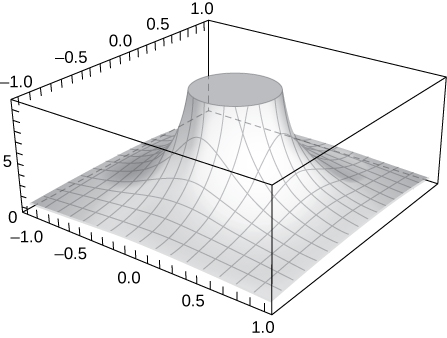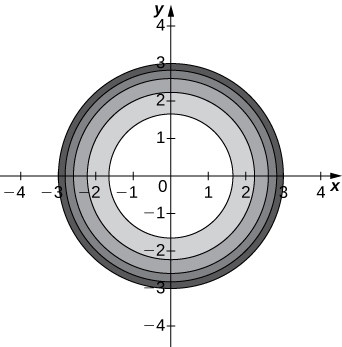Exercises for Limits and Continuity
- Last updated
- Jun 14, 2019
- Save as PDF
- Page ID
- 21120
( \newcommand{\kernel}{\mathrm{null}\,}\)
1) Use the limit laws for functions of two variables to evaluate each limit below, given that \displaystyle \lim_{(x,y)→(a,b)}f(x,y) = 5 and \displaystyle \lim_{(x,y)→(a,b)}g(x,y) = 2.
- \displaystyle \lim_{(x,y)→(a,b)}\left[f(x,y) + g(x,y)\right]
- \displaystyle \lim_{(x,y)→(a,b)}\left[f(x,y) g(x,y)\right]
- \displaystyle \lim_{(x,y)→(a,b)}\left[ \dfrac{7f(x,y)}{g(x,y)}\right]
- \displaystyle \lim_{(x,y)→(a,b)}\left[\dfrac{2f(x,y) - 4g(x,y)}{f(x,y) - g(x,y)}\right]
- Answer
-
- \displaystyle \lim_{(x,y)→(a,b)}\left[f(x,y) + g(x,y)\right] = \displaystyle \lim_{(x,y)→(a,b)}f(x,y) + \displaystyle \lim_{(x,y)→(a,b)}g(x,y)= 5 + 2 = 7
- \displaystyle \lim_{(x,y)→(a,b)}\left[f(x,y) g(x,y)\right] =\left(\displaystyle \lim_{(x,y)→(a,b)}f(x,y)\right) \left(\displaystyle \lim_{(x,y)→(a,b)}g(x,y)\right) = 5(2) = 10
- \displaystyle \lim_{(x,y)→(a,b)}\left[ \dfrac{7f(x,y)}{g(x,y)}\right] = \frac{7\left(\displaystyle \lim_{(x,y)→(a,b)}f(x,y)\right)}{\displaystyle \lim_{(x,y)→(a,b)}g(x,y)}=\frac{7(5)}{2} = 17.5
- \displaystyle \lim_{(x,y)→(a,b)}\left[\dfrac{2f(x,y) - 4g(x,y)}{f(x,y) - g(x,y)}\right] = \frac{2\left(\displaystyle \lim_{(x,y)→(a,b)}f(x,y)\right) - 4 \left(\displaystyle \lim_{(x,y)→(a,b)}g(x,y)\right)}{\displaystyle \lim_{(x,y)→(a,b)}f(x,y) - \displaystyle \lim_{(x,y)→(a,b)}g(x,y)}= \frac{2(5) - 4(2)}{5 - 2} = \frac{2}{3}
In exercises 2 - 4, find the limit of the function.
2) \displaystyle \lim_{(x,y)→(1,2)}x
3) \displaystyle \lim_{(x,y)→(1,2)}\frac{5x^2y}{x^2+y^2}
- Answer
- \displaystyle \lim_{(x,y)→(1,2)}\frac{5x^2y}{x^2+y^2} = 2
4) Show that the limit \displaystyle \lim_{(x,y)→(0,0)}\frac{5x^2y}{x^2+y^2} exists and is the same along the paths: y-axis and x-axis, and along y=x.
In exercises 5 - 19, evaluate the limits at the indicated values of x and y. If the limit does not exist, state this and explain why the limit does not exist.
5) \displaystyle \lim_{(x,y)→(0,0)}\frac{4x^2+10y^2+4}{4x^2−10y^2+6}
- Answer
- \displaystyle \lim_{(x,y)→(0,0)}\frac{4x^2+10y^2+4}{4x^2−10y^2+6} = \frac{2}{3}
6) \displaystyle \lim_{(x,y)→(11,13)}\sqrt{\frac{1}{xy}}
7) \displaystyle \lim_{(x,y)→(0,1)}\frac{y^2\sin x}{x}
- Answer
- \displaystyle \lim_{(x,y)→(0,1)}\frac{y^2\sin x}{x} = 1
8) \displaystyle \lim_{(x,y)→(0,0)}\sin(\frac{x^8+y^7}{x−y+10})
9) \displaystyle \lim_{(x,y)→(π/4,1)}\frac{y\tan x}{y+1}
- Answer
- \displaystyle \lim_{(x,y)→(π/4,1)}\frac{y\tan x}{y+1}=\frac{1}{2}
10) \displaystyle \lim_{(x,y)→(0,π/4)}\frac{\sec x+2}{3x−\tan y}
11) \displaystyle \lim_{(x,y)→(2,5)}(\frac{1}{x}−\frac{5}{y})
- Answer
- \displaystyle \lim_{(x,y)→(2,5)}(\frac{1}{x}−\frac{5}{y}) = −\frac{1}{2}
12) \displaystyle \lim_{(x,y)→(4,4)}x\ln y
13) \displaystyle \lim_{(x,y)→(4,4)}e^{−x^2−y^2}
- Answer
- \displaystyle \lim_{(x,y)→(4,4)}e^{−x^2−y^2} = e^{−32}
14) \displaystyle \lim_{(x,y)→(0,0)}\sqrt{9−x^2−y^2}
15) \displaystyle \lim_{(x,y)→(1,2)}(x^2y^3−x^3y^2+3x+2y)
- Answer
- \displaystyle \lim_{(x,y)→(1,2)}(x^2y^3−x^3y^2+3x+2y) = 11
16) \displaystyle \lim_{(x,y)→(π,π)}x\sin(\frac{x+y}{4})
17) \displaystyle \lim_{(x,y)→(0,0)}\frac{xy+1}{x^2+y^2+1}
- Answer
- \displaystyle \lim_{(x,y)→(0,0)}\frac{xy+1}{x^2+y^2+1} = 1
18) \displaystyle \lim_{(x,y)→(0,0)}\frac{x^2+y^2}{\sqrt{x^2+y^2+1}−1}
19) \displaystyle \lim_{(x,y)→(0,0)}\ln(x^2+y^2)
- Answer
- The limit does not exist because when x and y both approach zero, the function approaches \ln 0, which is undefined (approaches negative infinity).
In exercises 20 - 21, complete the statement.
20) A point (x_0,y_0) in a plane region R is an interior point of R if _________________.
21) A point (x_0,y_0) in a plane region R is called a boundary point of R if ___________.
- Answer
- Every open disk centered at (x_0,y_0) contains points inside R and outside R.
In exercises 22 - 25, use algebraic techniques to evaluate the limit.
22) \displaystyle \lim_{(x,y)→(2,1)}\frac{x−y−1}{\sqrt{x−y}−1}
23) \displaystyle \lim_{(x,y)→(0,0)}\frac{x^4−4y^4}{x^2+2y^2}
- Answer
- \displaystyle \lim_{(x,y)→(0,0)}\frac{x^4−4y^4}{x^2+2y^2} = 0
24) \displaystyle \lim_{(x,y)→(0,0)}\frac{x^3−y^3}{x−y}
25) \displaystyle \lim_{(x,y)→(0,0)}\frac{x^2−xy}{\sqrt{x}−\sqrt{y}}
- Answer
- \displaystyle \lim_{(x,y)→(0,0)}\frac{x^2−xy}{\sqrt{x}−\sqrt{y}} = 0
In exercises 26 - 27, evaluate the limits of the functions of three variables.
26) \displaystyle \lim_{(x,y,z)→(1,2,3)}\frac{xz^2−y^2z}{xyz−1}
27) \displaystyle \lim_{(x,y,z)→(0,0,0)}\frac{x^2−y^2−z^2}{x^2+y^2−z^2}
- Answer
- The limit does not exist.
In exercises 28 - 31, evaluate the limit of the function by determining the value the function approaches along the indicated paths. If the limit does not exist, explain why not.
28) \displaystyle \lim_{(x,y)→(0,0)}\frac{xy+y^3}{x^2+y^2}
a. Along the x-axis (y=0)
b. Along the y-axis (x=0)
c. Along the path y=2x
29) Evaluate \displaystyle \lim_{(x,y)→(0,0)}\frac{xy+y^3}{x^2+y^2} using the results of previous problem.
- Answer
- The limit does not exist. The function approaches two different values along different paths.
30) \displaystyle \lim_{(x,y)→(0,0)}\frac{x^2y}{x^4+y^2}
a. Along the x-axis (y=0)
b. Along the y-axis (x=0)
c. Along the path y=x^2
31) Evaluate \displaystyle \lim_{(x,y)→(0,0)}\frac{x^2y}{x^4+y^2} using the results of previous problem.
- Answer
- The limit does not exist because the function approaches two different values along the paths.
In exercises 32 - 35, discuss the continuity of each function. Find the largest region in the xy-plane in which each function is continuous.
32) f(x,y)=\sin(xy)
33) f(x,y)=\ln(x+y)
- Answer
- The function f is continuous in the region y>−x.
34) f(x,y)=e^{3xy}
35) f(x,y)=\dfrac{1}{xy}
- Answer
- The function f is continuous at all points in the xy-plane except at points on the x- and y-axes.
In exercises 36 - 38, determine the region in which the function is continuous. Explain your answer.
36) f(x,y)=\dfrac{x^2y}{x^2+y^2}
37) f(x,y)= \begin{cases}\dfrac{x^2y}{x^2+y^2} & if(x,y)≠(0,0)\\0 & if(x,y)=(0,0)\end{cases}
- Hint:
- Show that the function approaches different values along two different paths.
- Answer
- The function is continuous at (0,0) since the limit of the function at (0,0) is 0, the same value of f(0,0).
38) f(x,y)=\dfrac{\sin(x^2+y^2)}{x^2+y^2}
39) Determine whether g(x,y)=\dfrac{x^2−y^2}{x^2+y^2} is continuous at (0,0).
- Answer
- The function is discontinuous at (0,0). The limit at (0,0) fails to exist and g(0,0) does not exist.
40) Create a plot using graphing software to determine where the limit does not exist. Determine the region of the coordinate plane in which f(x,y)=\dfrac{1}{x^2−y} is continuous.
41) Determine the region of the xy-plane in which the composite function g(x,y)=\arctan(\frac{xy^2}{x+y}) is continuous. Use technology to support your conclusion.
- Answer
- Since the function \arctan x is continuous over (−∞,∞), g(x,y)=\arctan(\frac{xy^2}{x+y}) is continuous where z=\dfrac{xy^2}{x+y} is continuous. The inner function z is continuous on all points of the xy-plane except where y=−x. Thus, g(x,y)=\arctan(\frac{xy^2}{x+y}) is continuous on all points of the coordinate plane except at points at which y=−x.
42) Determine the region of the xy-plane in which f(x,y)=\ln(x^2+y^2−1) is continuous. Use technology to support your conclusion. (Hint: Choose the range of values for x and y carefully!)
43) At what points in space is g(x,y,z)=x^2+y^2−2z^2 continuous?
- Answer
- All points P(x,y,z) in space
44) At what points in space is g(x,y,z)=\dfrac{1}{x^2+z^2−1} continuous?
45) Show that \displaystyle \lim_{(x,y)→(0,0)}\frac{1}{x^2+y^2} does not exist at (0,0) by plotting the graph of the function.
- Answer
-
The graph increases without bound as x and y both approach zero.

46) [T] Evaluate \displaystyle \lim_{(x,y)→(0,0)}\frac{−xy^2}{x^2+y^4} by plotting the function using a CAS. Determine analytically the limit along the path x=y^2.
47) [T]
a. Use a CAS to draw a contour map of z=\sqrt{9−x^2−y^2}.
b. What is the name of the geometric shape of the level curves?
c. Give the general equation of the level curves.
d. What is the maximum value of z?
e. What is the domain of the function?
f. What is the range of the function?
- Answer
-
a.

b. The level curves are circles centered at (0,0) with radius 9−c.
c. x^2+y^2=9−c
d. z=3
e. \{(x,y)∈R^2∣x^2+y^2≤9\}
f. \{z|0≤z≤3\}
48) True or False: If we evaluate \displaystyle \lim_{(x,y)→(0,0)}f(x) along several paths and each time the limit is 1, we can conclude that \displaystyle \lim_{(x,y)→(0,0)}f(x)=1.
49) Use polar coordinates to find \displaystyle \lim_{(x,y)→(0,0)}\frac{\sin\sqrt{x^2+y^2}}{\sqrt{x^2+y^2}}. You can also find the limit using L’Hôpital’s rule.
- Answer
- \displaystyle \lim_{(x,y)→(0,0)}\frac{\sin\sqrt{x^2+y^2}}{\sqrt{x^2+y^2}} = 1
50) Use polar coordinates to find \displaystyle \lim_{(x,y)→(0,0)}\cos(x^2+y^2).
51) Discuss the continuity of f(g(x,y)) where f(t)=1/t and g(x,y)=2x−5y.
- Answer
- f(g(x,y)) is continuous at all points (x,y) that are not on the line 2x−5y=0.
52) Given f(x,y)=x^2−4y, find \displaystyle \lim_{h→0}\frac{f(x+h,y)−f(x,y)}{h}.
53) Given f(x,y)=x^2−4y, find \displaystyle \lim_{h→0}\frac{f(1+h,y)−f(1,y)}{h}.
- Answer
- \displaystyle \lim_{h→0}\frac{f(1+h,y)−f(1,y)}{h} = 2
Contributors
Gilbert Strang (MIT) and Edwin “Jed” Herman (Harvey Mudd) with many contributing authors. This content by OpenStax is licensed with a CC-BY-SA-NC 4.0 license. Download for free at http://cnx.org.
- Paul Seeburger (Monroe Community College) created problem 1.

